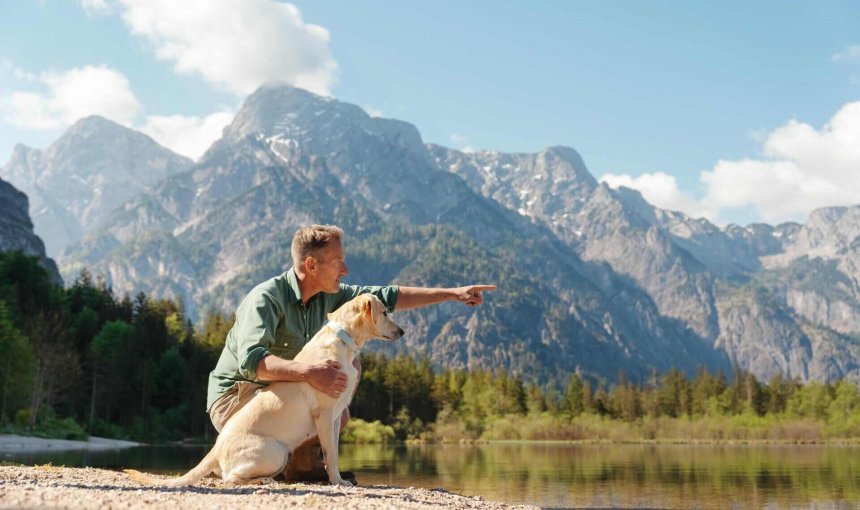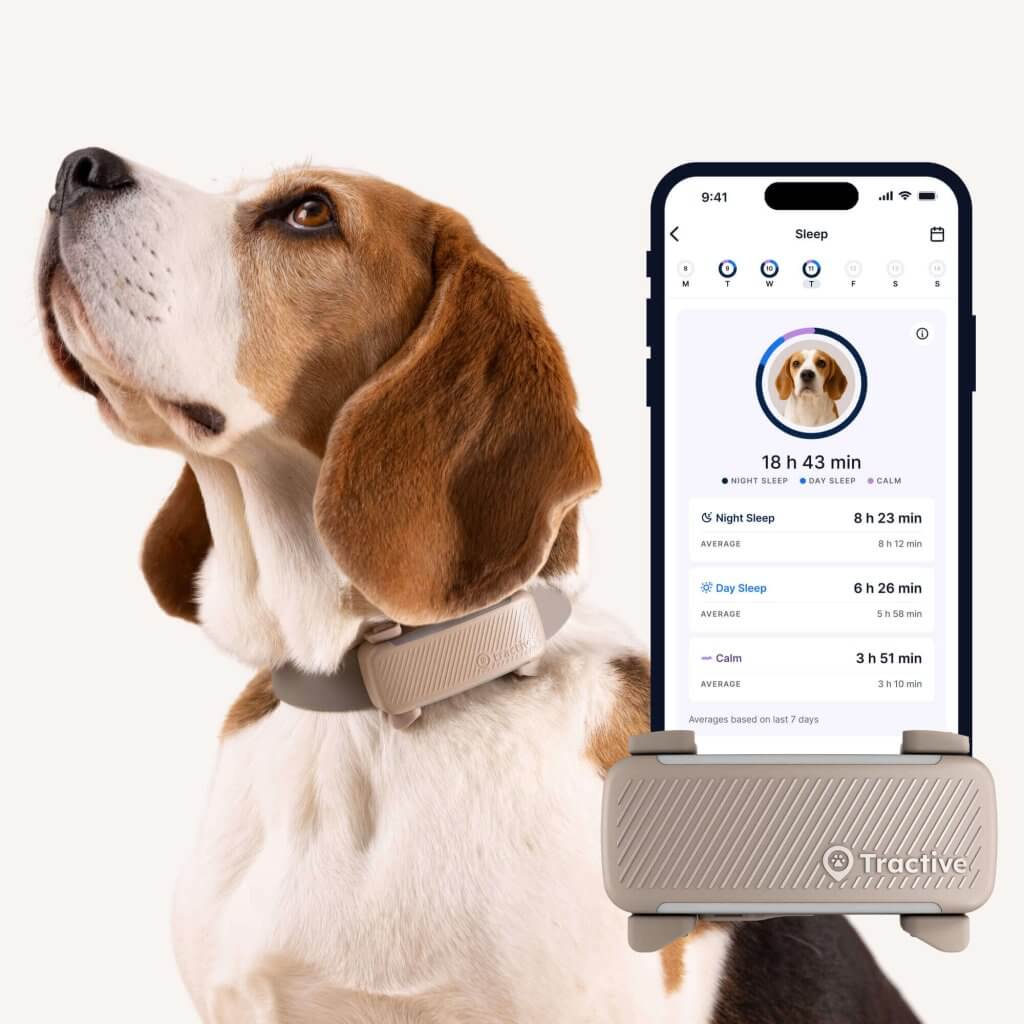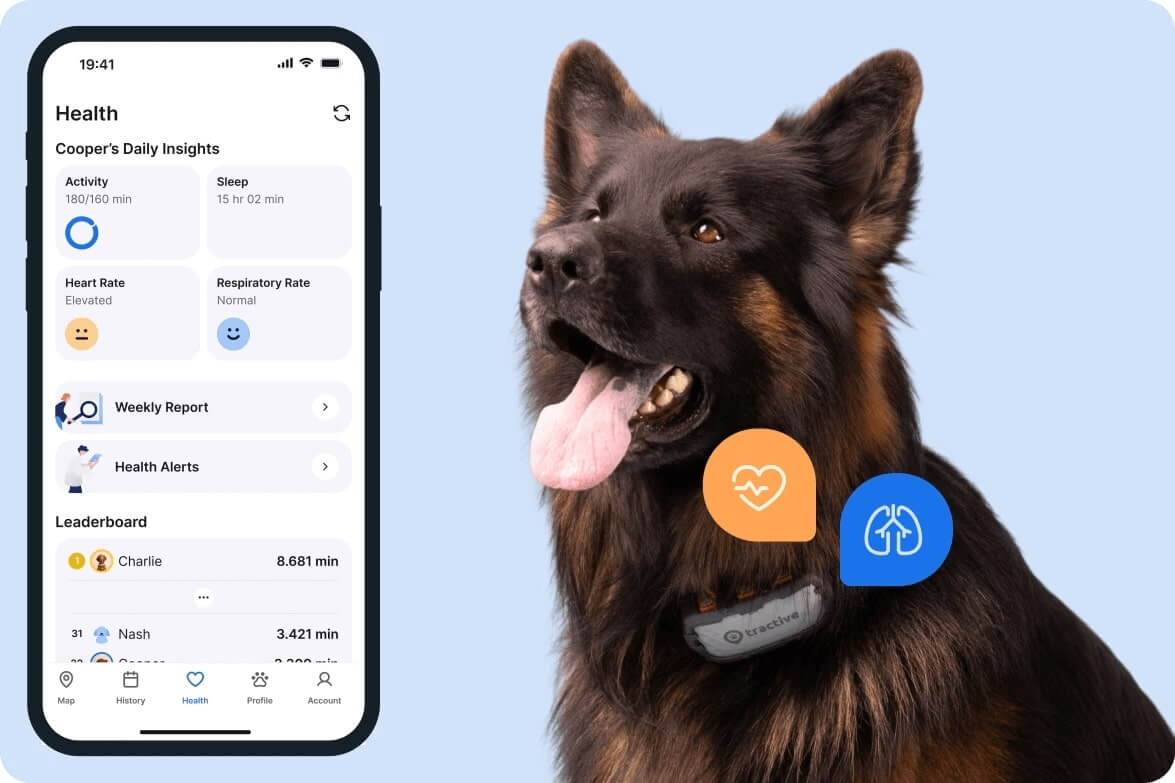 Approved by Dr. Dwight Alleyne, DVM
Approved by Dr. Dwight Alleyne, DVM How to Keep Your Dog Mentally Active: 7 Fun Activities
Giving your buddy a brain workout can help prevent them from experiencing cognitive decline as they grow older. Here are a couple of ways how.

You’re most likely taking your dog on daily walks to keep them healthy. But did you know that mental fitness is just as important as physical fitness for your pup’s overall well-being? Read our tips on how to keep your dog mentally active in this post. (And where a GPS & Health tracker for dogs can help you along the way.)

Always know your buddy is healthy & safe
Read moreWhy is mental stimulation for dogs so important?
Your dog’s grandparents were most likely herding, guarding, or tracking all day long. (All activities that kept them both physically and mentally active.) But in modern times, most dogs don’t get to put their instincts or breed traits to use. If your dog stays home alone most of the day, the lack of mental stimulation or purpose can make them bored, anxious, more likely to get up to mischief…and also more vulnerable to cognitive decline as they grow older.
On the bright side, most dogs require only 15 minutes of challenging activity per day to stay mentally fit. You’ll both deepen your bond – and prevent them from getting up to any destructive behavior.
💡An Activity Tracker for dogs can help you keep track of how much exercise your dog’s gotten throughout the day. So you can figure out whether to squeeze in one last game of fetch or let them get their well-earned rest.

Help your dog stay fit and healthy
Get a complete overview of how much exercise and rest they’re getting. Compare their activity to that of similar dogs. Set daily goals. And find out if something might be off with Health Alerts.
How to keep your dog mentally active: 7 fun activities
1) Obedience training
Basic dog obedience training is one of the most basic ways to engage your dog’s brain. It takes extreme focus from your dog as they listen to your commands and control their impulses. This is hard work for your pup! When they perform the requested behavior correctly, make sure to praise them plenty and maybe offer a dog treat as positive reinforcement. If your dog does not perform the behavior, don’t punish them – just ignore them.
A few minutes per day of reviewing basic commands like Come, Sit, and Stay will keep your dog’s brain stimulated. And the best news, it’s never too late to start. You can sign up for dog obedience classes, hire a dog trainer, or use video tools online.
Read more: 4 Important Dog Commands & How To Teach ‘Em
2) Make them work for food: food puzzles
You might be wondering how to keep your dog mentally active when you’re not at home all day. Which is where setting up an enriching home environment can go a long way. (And prevent any chewed up slippers or shredded cushions once you’re home!)
Your local pet store most likely includes treat dispensers, puzzle feeders, puzzle toys, and interactive devices. If your dog is hungry, they will be super-motivated to extract their food from the device. Puzzle toys make mealtime a problem-solving experience that lasts longer than simply placing a bowl of kibble in front of your pup.
- You could also use a peanut butter-stuffed kong toy or make your own puzzle feeder by cutting a few holes in a plastic bottle and placing some dry kibble inside.
- A cardboard egg carton is another DIY puzzle feeder option. The kibble you place in the puzzle feeder should be part of your dog’s daily diet, not extra food. Your dog will learn that the food falls out of the holes if they roll the bottle around or flip the egg carton upside down.
💡By swapping your dog’s toys out, your pup will have to re-learn how to solve the puzzles that were hidden away for a week. This creates extra mental stimulation for your pup.
3) Play hide & seek
An old-fashioned game of hide and seek is perfect for keeping your dog mentally stimulated on a cold or rainy day. Have a friend or family member sit with your dog while you go and hide. (This is where obedience training is super helpful, because your dog needs to “Stay” with your friend.)
Choose a hiding place where your dog can actually find you, like in the bathtub behind the shower curtain. Have your friend give the command to “Go find her/him!” Give your pup lots of verbal praise when they find you, along with a good ear scratch!
Read more: 13 Fun Games For Dogs (For When You’re Cooped Up Indoors)
4) Playdates & dog parks
Dogs are pack animals and enjoy hanging out with other dogs, too. Playdates and dog park visits give your pup a chance to interact with other dogs and practice their social skills, which is a form of mental stimulation. And you can be certain that your dog will get plenty of physical exercise at the dog park, too.
Running off-leash at the dog park is a huge thrill for most dogs. Be sure to keep a close eye on your pup and watch for aggressiveness, bullying, anxiety, or other negative behaviors from your dog or their playmates.
💡Make sure your dog is trained to “Come back” before you go to the dog park. Having this behavior down pat will enable you to remove your dog from any unsafe situations right away.
5) Teach your dog new tricks
Learning new tricks, or behaviors as they are called by trainers, is an extremely challenging brain workout for your dog. By using positive reinforcement, your dog will gain confidence and enjoy some mental stimulation. Rolling over, retrieving objects, or putting away toys are a few ideas to get you started.
One option is a dog version of the “shell game.” Place three plastic cups or bowls upside down, and tuck a treat under one of them as your dog watches. Shuffle the cups around and watch your dog do some nose work to sniff out the treat. Praise your dog plenty along with a treat when they find it.
Don’t be discouraged if your dog doesn’t learn the behavior on day one. Just keep practicing, or go back to the basics if the behavior is too complex. Try to end each session on a positive note by asking your dog to perform a known behavior, like Sit. Every training session provides mental stimulation that is important for your dog’s mental health.
6) Set up an obstacle course in your backyard
You don’t need much equipment to create a simple obstacle course for your dog. The purpose of an obstacle course should be to encourage your dog to problem-solve and move toward a goal, then reward them with praise or a treat – kind of like a dog treasure hunt.
An example of an indoor obstacle course is to drape blankets over a few chairs to create a tunnel. Encourage your dog to find their way through to the other side, where you await them. Place a box or big pillow in the center of the tunnel so your pup has to navigate around or over it. Your pup has to figure out how to get to you, which requires focus and is mentally stimulating.
Outdoors, employ the same techniques. Use benches, chairs, tomato stakes, and other items to create a winding path across your backyard. Gradually add more challenging experiences to the obstacle course as your dog masters the basics. For example, you could insert a box that your dog has to climb over, or lean a broom along the path so your dog has to go under it. You’re only limited by your imagination and the random stuff in your garage!
7) Get outdoors more often
The great outdoors is a perfect way for your dog to experience new mentally-stimulating sights, sounds, and smells. But before hitting the trail, consider your dog’s physical fitness and stamina. Can they handle a long hike? If not, a neighborhood stroll can be fun, too. Just try to mix up your route to keep it interesting.
Read more: Hiking With Dogs: Essential Tips For a Safe Adventure Together
Where a GPS & Health Tracker for dogs can step in
A bored dog is one that’s more likely to get up to mischief – and also experience cognitive decline as they get older. So how does a GPS & Health tracker come into play? Well, with a Tractive device strapped to your dog’s collar, you can now:
- Let your dog explore the outdoors, stress-free
With real-time LIVE Tracking, you can safely explore new trails, parks, and environments without worrying about them getting lost. Exploring new places stimulates their senses and keeps their mind engaged. - Keep track of how much exercise they’ve gotten
Regular Activity Monitoring helps you set and maintain healthy activity levels for your dog. Sent games, interactive walks, and playtime keeps their brains healthy while ensuring they get enough movement.

- Catch on to cognitive decline quicker
One of the first signs of cognitive decline in dogs is a change in their sleep patterns. With its built-in motion detector, your Tractive GPS helps you spot a drop in your dog’s sleep quality. So you can take them to a vet for a checkup much in advance. - Spot the signs of anxiety before they worsen
Your Tractive device comes with built-in Bark Monitoring and a Separation Anxiety monitor. This can help you catch on to an increase in barking or anxious behaviors like restless pacing. So you can drop by home on your lunch break, get someone to check on them, or even install a treat-dispensing pet camera to prevent them from getting lonely.
🐶 All this in one device – built with love for dogs and for your peace of mind as a dog parent.
Ready to help your dog live their healthiest life?
Whether it’s through interactive toys, training sessions, puzzle games, or exploring new environments, mental enrichment should be a key part of your dog’s daily routine.
Plus, with the Tractive GPS & Health Tracker, you can encourage your dog to explore safely, keep track of their exercise and sleep, and even spot a change in their behaviors early. (Which might signal anxiety or even cognitive decline.)
With the right balance of physical and mental exercise – plus a bit of tracking – you’ll be helping your buddy live their longest, healthiest, happiest life by your side.
Your furry friend’s health and wellbeing means as much as to us as it does to you. So we’ve made it a priority to only share medically-relevant content on our blog. This post was checked, double-checked, and medically verified by Georgia-based vet, Dr. Dwight Alleyne.

Dr. Dwight Alleyne, DVM
Originally from Long Island, New York, Dr. Alleyne began his career at a no-kill animal shelter before becoming a licensed veterinary technician. He graduated from Cornell University Veterinary College in 2006 and completed an internship at Purdue University. Now practicing in Georgia, Dr. Alleyne specializes in soft tissue surgery and ultrasounds. He also writes pet health articles on his website, “The Animal Doctor Blog” (www.anmldrblog.com).



